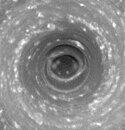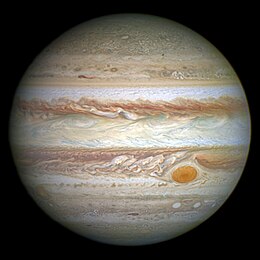The Saturn
(Saturn: Much ring holder,Internal structure, atmosphere, Moons,Planetary Rings,missions)
Saturn is the sixth planet from the Sun and the second-largest in the Solar System, after Jupiter.
It is a gas giant with an average radius about nine times that of
Earth. Although it has only one-eighth the average density of Earth,
with its larger volume Saturn is just over 95 times more massive. Saturn
is named after the Roman god of agriculture; its astronomical symbol (♄) represents the god's sickle.
Saturn's
interior is probably composed of a core of iron–nickel and rock
(silicon and oxygen compounds). This core is surrounded by a deep layer
of metallic hydrogen, an intermediate layer of liquid hydrogen and
liquid helium, and finally outside the Frenkel line a gaseous outer
layer. Saturn has a pale yellow hue due to ammonia crystals in its upper
atmosphere. Electrical current within the metallic hydrogen layer is
thought to give rise to Saturn's planetary magnetic field, which is
weaker than Earth's, but has a magnetic moment 580 times that of Earth
due to Saturn's larger size. Saturn's magnetic field strength is around
one-twentieth of Jupiter's. The outer atmosphere is generally bland and
lacking in contrast, although long-lived features can appear. Wind
speeds on Saturn can reach 1,800 km/h (500 m/s), higher than on Jupiter,
but not as high as those on Neptune.
Saturn
has a prominent ring system that consists of nine continuous main rings
and three discontinuous arcs and that is composed mostly of ice
particles with a smaller amount of rocky debris and dust. 62 moons are
known to orbit Saturn, of which fifty-three are officially named. This
does not include the hundreds of moonlets comprising the rings. Titan,
Saturn's largest moon, and the second-largest in the Solar System, is
larger than the planet Mercury, although less massive, and is the only
moon in the Solar System to have a substantial atmosphere
Internal structure
Despite consisting mostly of hydrogen and helium, most of Saturn's mass is not in the gas phase,
because hydrogen becomes a non-ideal liquid when the density is above
0.01 g/cm3, which is reached at a radius containing 99.9% of Saturn's
mass. The temperature, pressure, and density inside Saturn all rise
steadily toward the core, which causes hydrogen to transition into a
metal in the deeper layers.

Standard
planetary models suggest that the interior of Saturn is similar to that
of Jupiter, having a small rocky core surrounded by hydrogen and helium
with trace amounts of various volatiles. This core is similar in
composition to the Earth, but more dense. Examination of Saturn's
gravitational moment, in combination with physical models of the
interior, allowed French astronomers Didier Saumon and Tristan Guillot
to place constraints on the mass of Saturn's core. In 2004, they
estimated that the core must be 9–22 times the mass of the Earth, which
corresponds to a diameter of about 25,000 km. This is surrounded by a
thicker liquid metallic hydrogen layer, followed by a liquid layer of
helium-saturated molecular hydrogen that gradually transitions to a gas
with increasing altitude. The outermost layer spans 1,000 km and
consists of gas.
Saturn
has a hot interior, reaching 11,700 °C at its core, and it radiates 2.5
times more energy into space than it receives from the Sun. Jupiter's
thermal energy is generated by the Kelvin–Helmholtz mechanism of slow
gravitational compression, but this alone may not be sufficient to
explain heat production for Saturn, because it is less massive. An
alternative or additional mechanism may be generation of heat through
the "raining out" of droplets of helium deep in Saturn's interior. As
the droplets descend through the lower-density hydrogen, the process
releases heat by friction and leaves Saturn's outer layers depleted of
helium. These descending droplets may have accumulated into a helium
shell surrounding the core.
Atmosphere
The
outer atmosphere of Saturn contains 96.3% molecular hydrogen and 3.25%
helium by volume. The proportion of helium is significantly deficient
compared to the abundance of this element in the Sun. The quantity of
elements heavier than helium (metallicity) is not known precisely, but
the proportions are assumed to match the primordial abundances from the
formation of the Solar System. The total mass of these heavier elements
is estimated to be 19–31 times the mass of the Earth, with a significant
fraction located in Saturn's core region.
Trace
amounts of ammonia, acetylene, ethane, propane, phosphine and methane
have been detected in Saturn's atmosphere. The upper clouds are composed
of ammonia crystals, while the lower level clouds appear to consist of
either ammonium hydrosulfide (NH4SH) or water. Ultraviolet radiation
from the Sun causes methane photolysis in the upper atmosphere, leading
to a series of hydrocarbon chemical reactions with the resulting
products being carried downward by eddies and diffusion. This
photochemical cycle is modulated by Saturn's annual seasonal cycle.
Cloud layers
A global storm girdles the planet in 2011. The head of the storm (bright area) passes the tail circling around the left limb.
Saturn's atmosphere exhibits a banded pattern similar to Jupiter's, but Saturn's bands are much
fainter and are much wider near the equator. The nomenclature used to
describe these bands is the same as on Jupiter. Saturn's finer cloud
patterns were not observed until the flybys of the Voyager spacecraft
during the 1980s. Since then, Earth-based telescopy has improved to the
point where regular observations can be made.
The
composition of the clouds varies with depth and increasing pressure. In
the upper cloud layers, with the temperature in the range 100–160 K and
pressures extending between 0.5–2 bar, the clouds consist of ammonia
ice. Water ice clouds begin at a level where the pressure is about 2.5
bar and extend down to 9.5 bar, where temperatures range from 185–270 K.
Intermixed in this layer is a band of ammonium hydrosulfide ice, lying
in the pressure range 3–6 bar with temperatures of 290–235 K. Finally,
the lower layers, where pressures are between 10–20 bar and temperatures
are 270–330 K, contains a region of water droplets with ammonia in
aqueous solution.
Saturn's
usually bland atmosphere occasionally exhibits long-lived ovals and
other features common on Jupiter. In 1990, the Hubble Space Telescope
imaged an enormous white cloud near Saturn's equator that was not
present during the Voyager encounters, and in 1994 another smaller storm
was observed. The 1990 storm was an example of a Great White Spot, a
unique but short-lived phenomenon that occurs once every Saturnian year,
roughly every 30 Earth years, around the time of the northern
hemisphere's summer solstice. Previous Great White Spots were observed
in 1876, 1903, 1933 and 1960, with the 1933 storm being the most famous.
If the periodicity is maintained, another storm will occur in about
2020.
The
winds on Saturn are the second fastest among the Solar System's
planets, after Neptune's. Voyager data indicate peak easterly winds of
500 m/s (1800 km/h). In images from the Cassini spacecraft during 2007,
Saturn's northern hemisphere displayed a bright blue hue, similar to
Uranus. The color was most likely caused by Rayleigh scattering.
Thermography has shown that Saturn's south pole has a warm polar vortex,
the only known example of such a phenomenon in the Solar System.
Whereas temperatures on Saturn are normally −185 °C, temperatures on the
vortex often reach as high as −122 °C, suspected to be the warmest spot
on Saturn.
North pole hexagonal cloud pattern
 A
persisting hexagonal wave pattern around the north polar vortex in the
atmosphere at about 78°N was first noted in the Voyager images. The
sides of the hexagon are each about 13,800 km (8,600 mi) long, which is
longer than the diameter of the Earth. The entire structure
rotates with a period of 10h 39m 24s (the same period as that of the
planet's radio emissions) which is assumed to be equal to the period of
rotation of Saturn's interior. The hexagonal feature does not shift in
longitude like the other clouds in the visible atmosphere. The pattern's
origin is a matter of much speculation. Most scientists think it is a
standing wave pattern in the atmosphere. Polygonal shapes have been
replicated in the laboratory through differential rotation of fluids.
A
persisting hexagonal wave pattern around the north polar vortex in the
atmosphere at about 78°N was first noted in the Voyager images. The
sides of the hexagon are each about 13,800 km (8,600 mi) long, which is
longer than the diameter of the Earth. The entire structure
rotates with a period of 10h 39m 24s (the same period as that of the
planet's radio emissions) which is assumed to be equal to the period of
rotation of Saturn's interior. The hexagonal feature does not shift in
longitude like the other clouds in the visible atmosphere. The pattern's
origin is a matter of much speculation. Most scientists think it is a
standing wave pattern in the atmosphere. Polygonal shapes have been
replicated in the laboratory through differential rotation of fluids.
South pole vortex
HST
imaging of the south polar region indicates the presence of a jet
stream, but no strong polar vortex nor any hexagonal standing wave. NASA
reported in November 2006 that Cassini
had observed a "hurricane-like" storm locked to the south pole that had
a clearly defined eyewall. Eyewall clouds had not previously been seen
on any planet other than Earth. For example, images from the Galileo
spacecraft did not show an eyewall in the Great Red Spot of Jupiter.
The
south pole storm may have been present for billions of years. This
vortex is comparable to the size of Earth, and it has winds of 550 km/h.
Planetary rings
 Saturn
is probably best known for the system of planetary rings that makes it
visually unique. The rings extend from 6,630 km to 120,700 km outward
from Saturn's equator, average approximately 20 meters in thickness and
are composed of 93% water ice with traces of tholin impurities and 7%
amorphous carbon. The particles that make up the rings range in size
from specks of dust up to 10 m. While the other gas giants also have
ring systems, Saturn's is the largest and most visible.
Saturn
is probably best known for the system of planetary rings that makes it
visually unique. The rings extend from 6,630 km to 120,700 km outward
from Saturn's equator, average approximately 20 meters in thickness and
are composed of 93% water ice with traces of tholin impurities and 7%
amorphous carbon. The particles that make up the rings range in size
from specks of dust up to 10 m. While the other gas giants also have
ring systems, Saturn's is the largest and most visible.
There
are two main hypotheses regarding the origin of the rings. One
hypothesis is that the rings are remnants of a destroyed moon of Saturn.
The second hypothesis is that the rings are left over from the original
nebular material from which Saturn formed. Some ice in the E ring comes
from the moon Enceladus's geysers.
In
the past, astronomers once thought the rings formed alongside the
planet when it formed billions of years ago. Instead, the age of these
planetary rings is probably some hundreds of millions of years.
Beyond
the main rings at a distance of 12 million km from the planet is the
sparse Phoebe ring, which is tilted at an angle of 27° to the other
rings and, like Phoebe, orbits in retrograde fashion.
Some
of the moons of Saturn, including Pandora and Prometheus, act as
shepherd moons to confine the rings and prevent them from spreading out.
Pan and Atlas cause weak, linear density waves in Saturn's rings that
have yielded more reliable calculations of their masses.
History of observation and exploration
There
have been three main phases in the observation and exploration of
Saturn. The first era was ancient observations (such as with the naked
eye), before the invention of the modern telescopes. Starting in the
17th century progressively more advanced telescopic observations from
Earth have been made. The other type is visitation by spacecraft, either
by orbiting or flyby. In the 21st century observations continue from
the Earth (or Earth-orbiting observatories) and from the Cassini orbiter
at Saturn.
Modern NASA and ESA probes
Pioneer 11 flyby
Pioneer
11 carried out the first flyby of Saturn in September 1979, when it
passed within 20,000 km of the planet's cloud tops. Images were taken of
the planet and a few of its moons, although their resolution was too
low to discern surface detail. The spacecraft also studied Saturn's
rings, revealing the thin F-ring and the fact that dark gaps in the
rings are bright when viewed at high phase angle (towards the Sun),
meaning that they contain fine light-scattering material. In addition,
Pioneer 11 measured the temperature of Titan.
Voyager flybys
In
November 1980, the Voyager 1 probe visited the Saturn system. It sent
back the first high-resolution images of the planet, its rings and
satellites. Surface features of various moons were seen for the first
time. Voyager 1 performed a close flyby of Titan, increasing knowledge
of the atmosphere of the moon. It proved that Titan's atmosphere is
impenetrable in visible wavelengths; therefore no surface details were
seen. The flyby changed the spacecraft's trajectory out from the plane
of the Solar System.
Almost
a year later, in August 1981, Voyager 2 continued the study of the
Saturn system. More close-up images of Saturn's moons were acquired, as
well as evidence of changes in the atmosphere and the rings.
Unfortunately, during the flyby, the probe's turnable camera platform
stuck for a couple of days and some planned imaging was lost. Saturn's
gravity was used to direct the spacecraft's trajectory towards Uranus.
The
probes discovered and confirmed several new satellites orbiting near or
within the planet's rings, as well as the small Maxwell Gap (a gap
within the C Ring) and Keeler gap (a 42 km wide gap in the A Ring).
Cassini–Huygens spacecraft
On
1 July 2004, the Cassini–Huygens space probe performed the SOI (Saturn
Orbit Insertion) maneuver and entered orbit around Saturn. Before the
SOI, Cassini had already studied the system extensively. In June 2004,
it had conducted a close flyby of Phoebe, sending back high-resolution
images and data.
Cassini's
flyby of Saturn's largest moon, Titan, has captured radar images of
large lakes and their coastlines with numerous islands and mountains.
The orbiter completed two Titan flybys before releasing the Huygens
probe on 25 December 2004. Huygens descended onto the surface of Titan
on 14 January 2005, sending a flood of data during the atmospheric descent and after the landing. Cassini has since conducted multiple flybys of Titan and other icy satellites.
Since
early 2005, scientists have been tracking lightning on Saturn. The
power of the lightning is approximately 1,000 times that of lightning on
Earth.
At Enceladus's south pole geysers spray water from many locations along the tiger stripes.
In
2006, NASA reported that Cassini had found evidence of liquid water
reservoirs that erupt in geysers on Saturn's moon Enceladus. Images had
shown jets of icy particles being emitted into orbit around Saturn from
vents in the moon's south polar region. According to Andrew Ingersoll,
California Institute of Technology, "Other moons in the Solar System
have liquid-water oceans covered by kilometers of icy crust. What's
different here is that pockets of liquid water may be no more than tens
of meters below the surface." Over 100 geysers have been identified on
Enceladus. In May 2011, NASA scientists at an Enceladus Focus Group
Conference reported that Enceladus "is emerging as the most habitable
spot beyond Earth in the Solar System for life as we know it".
Cassini
photographs have led to other significant discoveries. They have
revealed a previously undiscovered planetary ring, outside the brighter
main rings of Saturn and inside the G and E rings. The source of this
ring is hypothesized to be the crashing of a meteoroid off Janus and
Epimetheus. In July 2006, Cassini images provided evidence of
hydrocarbon lakes near Titan's north pole, the presence of which were
confirmed in January 2007. In March 2007, additional images near Titan's
north pole revealed hydrocarbon seas, the largest of which is almost
the size of the Caspian Sea. In October 2006, the probe detected an
8,000 km diameter cyclone-like storm with an eyewall at Saturn's south
pole.
From
2004 to 2 November 2009, the probe discovered and confirmed eight new
satellites. Its primary mission ended in 2008 when the spacecraft had
completed 74 orbits around the planet. The probe's mission was extended
to September 2010 and then extended again to 2017, to study a full
period of Saturn's seasons.
In
April 2013 Cassini sent back images of a hurricane at the planet's
north pole 20 times larger than those found on Earth, with winds faster
than 530 km/h.
On
19 July 2013, "The Day the Earth Smiled", Cassini was pointed towards
Earth to capture an image of the Earth and the Moon (and, as well, Venus
and Mars) as part of a natural light, multi-image portrait of the
entire Saturn system. It was the first time NASA informed the people of
Earth that a long-distance photo was being taken in advance.
Possible future missions
The
continued exploration of Saturn is still considered to be a viable
option for NASA as part of their ongoing New Frontiers program of
missions. NASA previously requested for plans to be put forward for a
mission to Saturn that included an atmospheric entry probe and possible
investigations into the habitability and possible discovery of life on
Saturn's moons Titan and Enceladus.
 A
persisting hexagonal wave pattern around the north polar vortex in the
atmosphere at about 78°N was first noted in the Voyager images. The
sides of the hexagon are each about 13,800 km (8,600 mi) long, which is
longer than the diameter of the Earth. The entire structure
rotates with a period of 10h 39m 24s (the same period as that of the
planet's radio emissions) which is assumed to be equal to the period of
rotation of Saturn's interior. The hexagonal feature does not shift in
longitude like the other clouds in the visible atmosphere. The pattern's
origin is a matter of much speculation. Most scientists think it is a
standing wave pattern in the atmosphere. Polygonal shapes have been
replicated in the laboratory through differential rotation of fluids.
A
persisting hexagonal wave pattern around the north polar vortex in the
atmosphere at about 78°N was first noted in the Voyager images. The
sides of the hexagon are each about 13,800 km (8,600 mi) long, which is
longer than the diameter of the Earth. The entire structure
rotates with a period of 10h 39m 24s (the same period as that of the
planet's radio emissions) which is assumed to be equal to the period of
rotation of Saturn's interior. The hexagonal feature does not shift in
longitude like the other clouds in the visible atmosphere. The pattern's
origin is a matter of much speculation. Most scientists think it is a
standing wave pattern in the atmosphere. Polygonal shapes have been
replicated in the laboratory through differential rotation of fluids.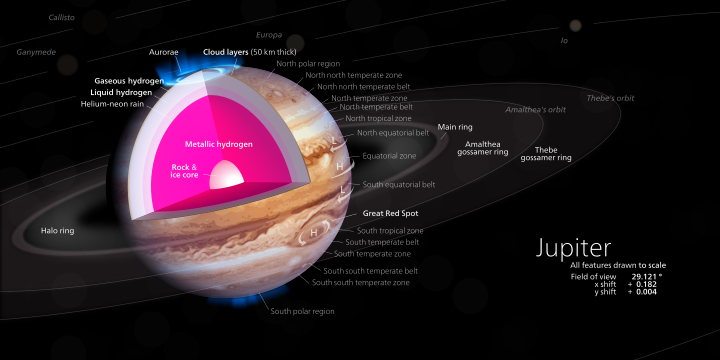
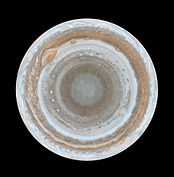 Jupiter has the largest planetary atmosphere in the Solar System, spanning over 5,000 km
(3,000 mi) in altitude. Because Jupiter has no surface, the base of its
atmosphere is usually considered to be the point at which atmospheric
pressure is equal to 100 kPa (1.0 bar).
Jupiter has the largest planetary atmosphere in the Solar System, spanning over 5,000 km
(3,000 mi) in altitude. Because Jupiter has no surface, the base of its
atmosphere is usually considered to be the point at which atmospheric
pressure is equal to 100 kPa (1.0 bar). Time-lapse
sequence from the approach of Voyager 1, showing the motion of
atmospheric bands and circulation of the Great Red Spot. Recorded over
32 days with one photograph taken every 10 hours (once per Jovian day).
See full size video.
Time-lapse
sequence from the approach of Voyager 1, showing the motion of
atmospheric bands and circulation of the Great Red Spot. Recorded over
32 days with one photograph taken every 10 hours (once per Jovian day).
See full size video.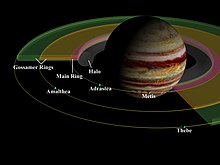 Jupiter
has a faint planetary ring system composed of three main segments: an
inner torus of particles known as the halo, a relatively bright main
ring, and an outer gossamer ring. These rings appear to be made of dust,
rather than ice as with Saturn's rings. The main ring is probably made
of material ejected from the satellites Adrastea and Metis. Material
that would normally fall back to the moon is pulled into Jupiter because
of its strong gravitational
influence. The orbit of the material veers towards Jupiter and new
material is added by additional impacts. In a similar way, the moons
Thebe and Amalthea probably produce the two distinct components of the
dusty gossamer ring. There is also evidence of a rocky ring strung along
Amalthea's orbit which may consist of collisional debris from that
moon.
Jupiter
has a faint planetary ring system composed of three main segments: an
inner torus of particles known as the halo, a relatively bright main
ring, and an outer gossamer ring. These rings appear to be made of dust,
rather than ice as with Saturn's rings. The main ring is probably made
of material ejected from the satellites Adrastea and Metis. Material
that would normally fall back to the moon is pulled into Jupiter because
of its strong gravitational
influence. The orbit of the material veers towards Jupiter and new
material is added by additional impacts. In a similar way, the moons
Thebe and Amalthea probably produce the two distinct components of the
dusty gossamer ring. There is also evidence of a rocky ring strung along
Amalthea's orbit which may consist of collisional debris from that
moon.






